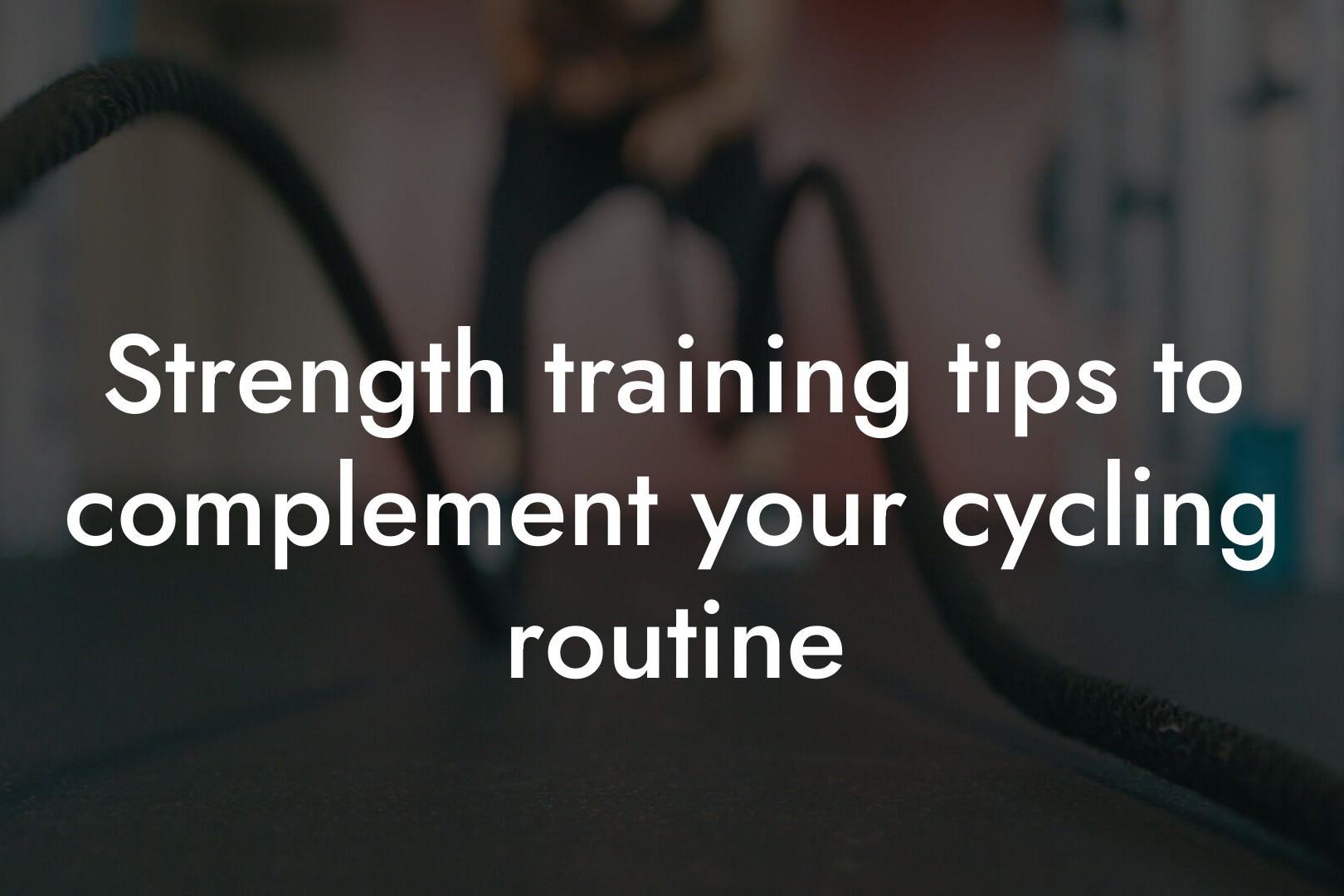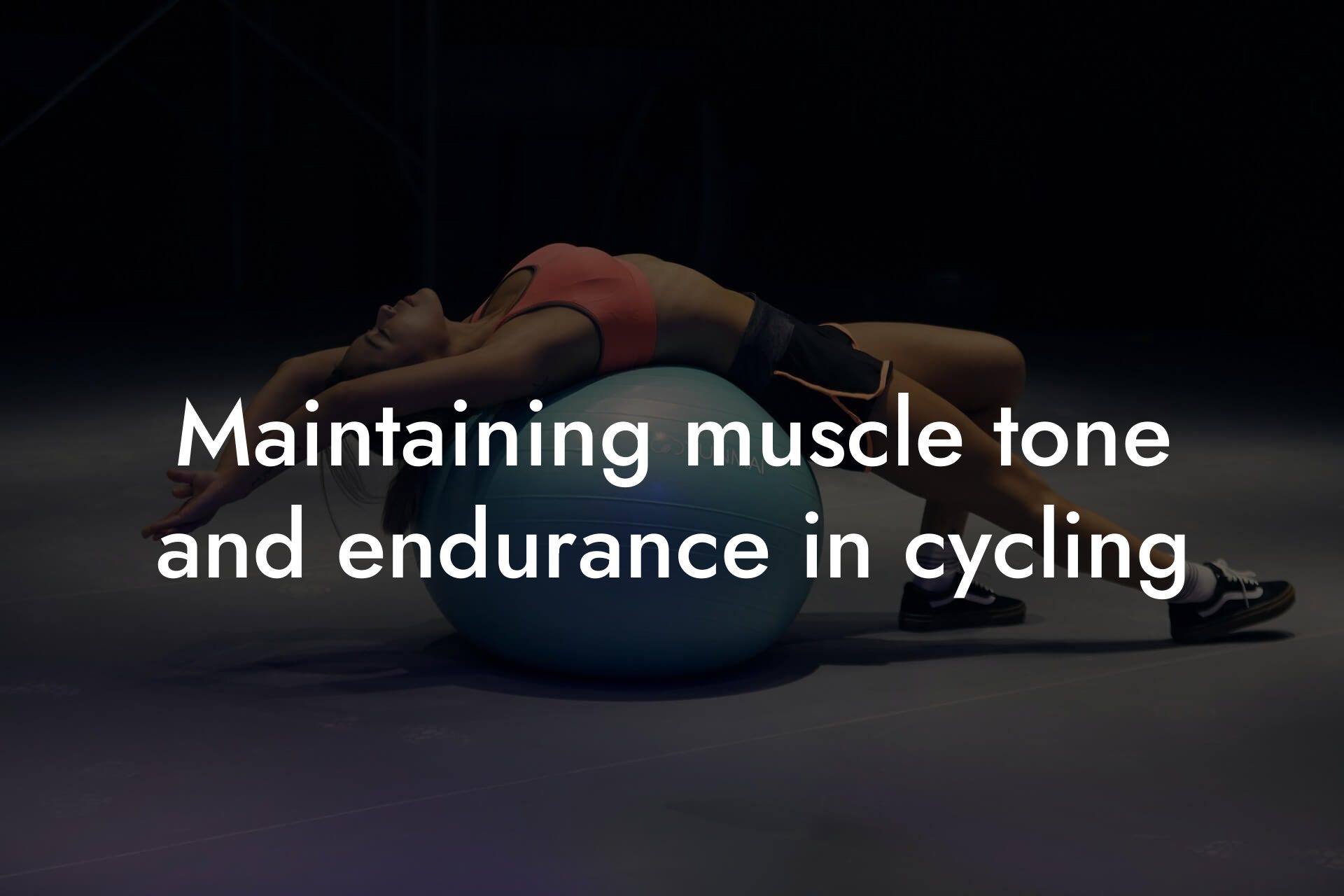As a high-earning professional, you understand the importance of maintaining a healthy and fit physique. Spin classes are an excellent way to improve cardiovascular health, increase endurance, and boost overall fitness. However, it's essential to strike a balance between strength and endurance to get the most out of your spin classes and avoid plateaus or injuries. In this article, we'll delve into the importance of balancing strength and endurance in spin classes, and provide you with practical tips and strategies to achieve optimal results.
Table of Contents
- Understanding the Importance of Strength in Spin Classes
- The Role of Endurance in Spin Classes
- The Importance of Balancing Strength and Endurance
- Practical Tips for Balancing Strength and Endurance in Spin Classes
- Sample Workout Routine for Balancing Strength and Endurance
- Common Mistakes to Avoid When Balancing Strength and Endurance
- The Role of DEXA Scans in Balancing Strength and Endurance
- Frequently Asked Questions
Understanding the Importance of Strength in Spin Classes
When it comes to spin classes, many people focus solely on endurance, neglecting the crucial role strength plays in overall performance. Building strength in your legs, core, and upper body is essential for generating power, speed, and efficiency on the bike. Stronger muscles also help to reduce the risk of injury, improve pedaling technique, and enhance overall cycling performance.
In a spin class, strength is critical for explosive movements, such as sprints and climbs. It's also essential for maintaining good form and posture, which helps to prevent fatigue, discomfort, and injury. By incorporating strength training into your spin class routine, you can improve your overall performance, increase your power output, and ride more efficiently.
The Role of Endurance in Spin Classes
Endurance is a critical component of spin classes, as it allows you to sustain a high intensity effort over a prolonged period. Building endurance in your cardiovascular system, lungs, and muscles enables you to ride longer, faster, and more efficiently. Endurance training also helps to improve your body's ability to utilize fat as a fuel source, increasing your stamina and reducing fatigue.
In a spin class, endurance is essential for completing high-intensity interval training (HIIT) workouts, which are designed to push your body to its limits. By building endurance, you can recover faster between intervals, maintain a higher intensity, and get more out of your workout.
The Importance of Balancing Strength and Endurance
Balancing strength and endurance is critical in spin classes, as it allows you to optimize your performance, reduce the risk of injury, and achieve your fitness goals. When you focus too much on endurance, you may neglect your strength training, leading to muscle imbalances, poor form, and increased risk of injury. Conversely, if you focus too much on strength, you may neglect your endurance training, leading to poor cardiovascular fitness and reduced stamina.
By balancing strength and endurance, you can create a well-rounded fitness program that addresses all aspects of your cycling performance. This balanced approach helps to improve your overall fitness, increase your power output, and enhance your overall cycling experience.
Practical Tips for Balancing Strength and Endurance in Spin Classes
So, how can you balance strength and endurance in your spin classes? Here are some practical tips to get you started:
- Incorporate strength training exercises into your spin class routine, such as leg press, squats, and lunges. Focus on exercises that target your legs, core, and upper body.
- Incorporate endurance training into your spin class routine, such as high-intensity interval training (HIIT) workouts and steady-state cardio. Focus on exercises that challenge your cardiovascular system and improve your stamina.
- Alternate between strength and endurance training days to allow for adequate recovery and adaptation.
- Incorporate functional exercises that mimic cycling movements, such as step-ups and box jumps, to improve your power output and pedaling technique.
- Focus on proper form and technique, as poor form can lead to muscle imbalances, poor performance, and increased risk of injury.
Sample Workout Routine for Balancing Strength and Endurance
Here's a sample workout routine that balances strength and endurance in a spin class:
- Warm-up: 5-minute easy spin
- Strength training: 3 sets of 10 reps of leg press, followed by 3 sets of 10 reps of squats
- Endurance training: 20-minute HIIT workout, consisting of 30 seconds of high-intensity cycling followed by 30 seconds of active recovery
- Cool-down: 5-minute easy spin
Common Mistakes to Avoid When Balancing Strength and Endurance
When balancing strength and endurance in spin classes, it's essential to avoid common mistakes that can lead to poor performance, injury, or plateaus. Here are some common mistakes to avoid:
- Focusing too much on endurance training, neglecting strength training
- Focusing too much on strength training, neglecting endurance training
- Neglecting proper form and technique
- Not allowing for adequate recovery and adaptation time
- Not incorporating functional exercises that mimic cycling movements
The Role of DEXA Scans in Balancing Strength and Endurance
At Tano Performance Group, we understand the importance of balancing strength and endurance in spin classes. That's why we offer DEXA scans, which provide a comprehensive body assessment and help you optimize your fitness program. DEXA scans measure your body fat percentage, lean muscle mass, bone density, and other key metrics, providing you with valuable insights to improve your overall fitness and performance.
By incorporating DEXA scans into your fitness program, you can:
- Identify areas for improvement, such as muscle imbalances or poor bone density
- Create a personalized fitness program that addresses your specific needs and goals
- Track your progress and adjust your program as needed
- Achieve optimal results and take your fitness to the next level
Balancing strength and endurance in spin classes is critical for optimal performance, injury prevention, and overall fitness. By understanding the importance of strength and endurance, incorporating practical tips and strategies into your routine, and avoiding common mistakes, you can create a well-rounded fitness program that addresses all aspects of your cycling performance. Remember to incorporate DEXA scans into your fitness program to optimize your results and take your fitness to the next level.
Frequently Asked Questions
What is the importance of balancing strength and endurance in spin classes?
Balancing strength and endurance in spin classes is crucial because it allows riders to optimize their performance, reduce the risk of injury, and achieve their fitness goals. When you focus solely on endurance, you may neglect building the strength needed to support your joints and muscles, leading to fatigue and potential injuries. On the other hand, prioritizing strength alone can lead to plateaus and neglect of cardiovascular benefits. By balancing both, you'll experience a more well-rounded workout and improved overall fitness.
How do I know if I'm focusing too much on endurance in my spin classes?
If you're consistently taking spin classes and feeling like you're not seeing improvements in your overall strength or muscle tone, you may be focusing too much on endurance. Additionally, if you're experiencing fatigue, joint pain, or muscle imbalances, it could be a sign that you need to incorporate more strength-focused exercises into your routine.
What are some common mistakes riders make when it comes to balancing strength and endurance?
One common mistake is neglecting to incorporate strength training exercises into their routine, assuming that cardio-focused spin classes are enough. Another mistake is focusing too much on high-intensity interval training (HIIT) without incorporating lower-intensity, endurance-focused workouts. Finally, riders may not be listening to their bodies and taking rest days or modifying exercises to avoid injury.
How can I modify my spin class routine to incorporate more strength training?
There are several ways to modify your spin class routine to incorporate more strength training. You can try adding strength-focused exercises like squats, lunges, or leg press to your warm-up or cool-down. You can also incorporate resistance bands or light weights into your ride to target specific muscle groups. Additionally, consider taking a strength-focused spin class or working with a personal trainer to develop a customized strength training plan.
What are some exercises I can do outside of spin class to improve my overall strength?
There are many exercises you can do outside of spin class to improve your overall strength. These include squats, lunges, deadlifts, leg press, and calf raises to target your lower body. You can also incorporate exercises like push-ups, rows, and shoulder presses to target your upper body. Don't forget to incorporate core exercises like planks, Russian twists, and leg raises to improve your overall stability and balance.
How often should I take spin classes to see improvements in my endurance?
The frequency of spin classes needed to see improvements in endurance will vary depending on your individual fitness goals and current fitness level. As a general rule, taking 2-3 spin classes per week can help improve cardiovascular endurance, while taking 3-4 classes per week can help improve muscular endurance. However, it's essential to listen to your body and not overdo it, as overtraining can lead to fatigue and injury.
What is the ideal intensity level for a spin class focused on endurance?
The ideal intensity level for a spin class focused on endurance will vary depending on your individual fitness level and goals. As a general rule, an endurance-focused spin class should be moderate to low intensity, with a perceived exertion level of 5-7 out of 10. This will allow you to maintain a steady pace and focus on building cardiovascular endurance without pushing yourself too hard.
How can I measure my progress in terms of endurance in spin classes?
There are several ways to measure progress in terms of endurance in spin classes. You can track your distance, speed, or watts output during each class. You can also pay attention to your perceived exertion level, heart rate, or rate of perceived exertion (RPE). Finally, you can track your overall fitness level by monitoring your resting heart rate, body fat percentage, or other health metrics.
What are some tips for staying motivated and avoiding plateaus in spin classes?
Staying motivated and avoiding plateaus in spin classes requires a combination of physical and mental strategies. Physically, try mixing up your routine by taking different types of classes, incorporating new exercises, or setting specific fitness goals. Mentally, focus on finding a workout buddy, setting rewards for yourself, or tracking your progress to stay motivated.
How can I incorporate strength training into my spin class routine without sacrificing endurance?
Incorporating strength training into your spin class routine without sacrificing endurance requires a balanced approach. Try incorporating strength-focused exercises during the warm-up or cool-down, or incorporating resistance bands or light weights into your ride. You can also alternate between strength-focused and endurance-focused classes to ensure a balanced workout routine.
What are some common injuries associated with spin classes, and how can I prevent them?
Common injuries associated with spin classes include knee pain, hip pain, and lower back strain. To prevent these injuries, make sure to warm up properly before class, listen to your body and take regular breaks, and focus on proper form and technique. Additionally, incorporate strength training exercises into your routine to build the strength and stability needed to support your joints and muscles.
How can I adjust my spin class routine to accommodate injuries or physical limitations?
Adjusting your spin class routine to accommodate injuries or physical limitations requires a combination of physical and mental adaptations. Physically, try modifying exercises to reduce impact or stress on the affected area. Mentally, focus on finding alternative exercises or modifications that allow you to continue working out while avoiding exacerbating the injury.
What role does nutrition play in balancing strength and endurance in spin classes?
Nutrition plays a critical role in balancing strength and endurance in spin classes. A well-balanced diet that includes adequate protein, complex carbohydrates, and healthy fats can help support muscle growth and recovery. Additionally, staying hydrated before, during, and after class is essential for optimal performance and recovery.
How can I use heart rate monitoring to optimize my spin class routine?
Heart rate monitoring can be a valuable tool for optimizing your spin class routine. By tracking your heart rate, you can ensure that you're working at the right intensity level to achieve your fitness goals. You can also use heart rate monitoring to track your progress over time and make adjustments to your routine as needed.
What are some benefits of incorporating strength training into my spin class routine?
Incorporating strength training into your spin class routine can have numerous benefits, including increased muscle mass, improved bone density, and enhanced overall fitness. Strength training can also help improve your power output, endurance, and overall performance in spin classes.
How can I balance strength and endurance training with other forms of exercise?
Balancing strength and endurance training with other forms of exercise requires a well-rounded approach. Try incorporating different types of exercise, such as yoga, Pilates, or weightlifting, into your routine to ensure a balanced fitness routine. Additionally, make sure to listen to your body and take rest days as needed to avoid overtraining.
What are some common myths about strength and endurance training in spin classes?
One common myth is that strength training is only for bodybuilders or athletes, when in reality, it's essential for overall fitness and injury prevention. Another myth is that endurance training is only for cardio-focused workouts, when in reality, it's essential for building muscular endurance and overall fitness.
How can I work with a personal trainer or coach to develop a customized strength and endurance training plan?
Working with a personal trainer or coach can be a valuable investment in your fitness journey. They can help you develop a customized strength and endurance training plan that takes into account your individual fitness goals, fitness level, and physical limitations. They can also provide guidance on proper form and technique, as well as accountability and motivation.
What are some tips for staying motivated and accountable in my strength and endurance training?
Staying motivated and accountable in your strength and endurance training requires a combination of physical and mental strategies. Physically, try setting specific fitness goals and tracking your progress. Mentally, focus on finding a workout buddy, setting rewards for yourself, or working with a personal trainer or coach to stay motivated and accountable.
How can I use technology, such as fitness apps or tracking devices, to optimize my strength and endurance training?
Technology can be a valuable tool for optimizing your strength and endurance training. Fitness apps and tracking devices can help you track your progress, monitor your heart rate and other health metrics, and stay motivated and accountable. Additionally, many apps and devices offer personalized workout plans and coaching to help you achieve your fitness goals.
Here are some related articles you might love...
- Strength training tips to complement your cycling routine
- Maintaining muscle tone and endurance in cycling
- The role of cycling in cardiovascular health
- How DEXA scans can benefit cycling enthusiasts
- Nutrition strategies for sustained energy during spin classes
- Bone density and its role in cycling performance
- How body composition affects cycling performance
- Recovery techniques for cyclists after intense sessions
Zak Faulkner
Zak Faulkner is a leading authority in the realm of physical health and body composition analysis, with over 15 years of experience helping professionals optimise their fitness and well-being. As one the experts behind Tano Performance Group, Zak has dedicated his career to providing in-depth, science-backed insights that empower clients to elevate their physical performance and overall health.
With extensive knowledge of DEXA technology, Zak specializes in delivering comprehensive body assessments that offer precise data on body fat, muscle mass, bone density, and overall physique. His expertise enables individuals to make informed decisions and achieve their fitness goals with accuracy and confidence. Zak’s approach is rooted in a deep understanding of human physiology, combined with a passion for helping clients unlock their full potential through personalised strategies.
Over the years, Zak has earned a reputation for his commitment to excellence, precision, and client-focused service. His guidance is trusted by top professionals who demand the best when it comes to their health. Whether advising on fitness programs, nutritional strategies, or long-term wellness plans, Zak Faulkner’s insights are a valuable resource for anyone serious about taking their health and fitness to the next level.
At Tano Performance Group, Zak continues to lead our Content Team revolutionising how professionals approach their physical health, offering unparalleled expertise that drives real results.




